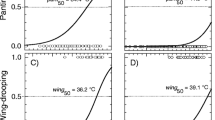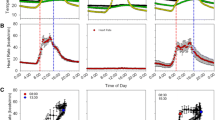Abstract
Temperature regulation and oxygen consumption were examined in two species of grasshoppers: Melanoplus sanguinipes from cold alpine tundra at elevation 3,800 m, and Trimerotropis pallidipennis from hot desert habitats at elevation 250 m. Both species utilized behavioral thermoregulation to keep body temperature (T b ) more constant than environmental temperatures (T e ) during the day. The difference in average T b in the two species was much less than the difference in T e 's. Microclimate measurements indicate that temperature regulation is not difficult for M. sanguinipes, but T. pallidipennis must restrict activity for much of the day to avoid heat stress and can easily overheat if it moves into sunlit areas. Oxygen consumption (\(\dot V{\text{O}}_{\text{2}} \)) at average T b and total daily energy expenditures are higher in M. sanguinipes than in T. pallidipennis, as is the Q10 for \(\dot V{\text{O}}_{\text{2}} \). These differences may be related to different strategies for energy utilization and predator avoidance.
Similar content being viewed by others
References
Anderson RV, Tracy CR, Abramsky Z (1979) Habitat selection in two species of short-horned grasshoppers. Oecologia 38:359–374
Bakken GS (1976) A heat transfer analysis of animals: Unifying concepts and the application of metabolism chamber data to field ecology. J Theoret Biol 60:337–384
Bartholomew GA (1977) Body temperature and energy metabolism. In: Gordon MS (ed), Animal Physiology, Principles and Adaptations. MacMillan, New York, pp 364–449
Bartholomew GA (1981) A matter of size: An examination of endothermy in insects and terrestrial vertebrates. In: Heinrich B (ed), Insect Thermoregulation. John Wiley and Sons, New York, pp 45–78
Casey TM (1981) Behavioral mechanisms of thermoregulation. In: Heinrich B (ed), Insect Thermoregulation. John Wiley and Sons, New York, pp 79–114
Chappell MA, Bartholomew GA (1981) Standard operative temperatures and thermal energetics of the antelope ground squirrel Ammospermophilus leucurus. Physiol Zool 54:81–93
Church NS (1960 a) Heat loss and the body temperature of flying insects. I. Heat loss by evaporation of water from the body. J Exp Biol 37:171–185
Church NS (1960 b) Heat loss and the body temperature of flying insects. II. Heat conduction within the body and its loss by radiation and convection. J Exp Biol 37:186–213
Digby PSB (1955) Factors affecting the temperature excess of insects in sunshine. J Exp Biol 32:279–298
Uvarov B (1977) Grasshoppers and Locusts, A Handbook of General Acridology, vol. 2. Centre for Overseas Pest Research, London
Waloff Z (1963) Field studies on solitary and transient desert locusts in the Red Sea area. Anti-Locust Bull 40:1–93
Weis-Fogh T (1956) Biology and physics of locust flight. II. Flight performance of the desert locust (Schistocerca gregaria). Phil Trans R Soc Lond B 239:459–510
Author information
Authors and Affiliations
Additional information
Contribution No. 7 of the University of California Natural Land and Water Reserve System
Rights and permissions
About this article
Cite this article
Chappell, M.A. Metabolism and thermoregulation in desert and montane grasshoppers. Oecologia 56, 126–131 (1983). https://doi.org/10.1007/BF00378228
Received:
Issue Date:
DOI: https://doi.org/10.1007/BF00378228




